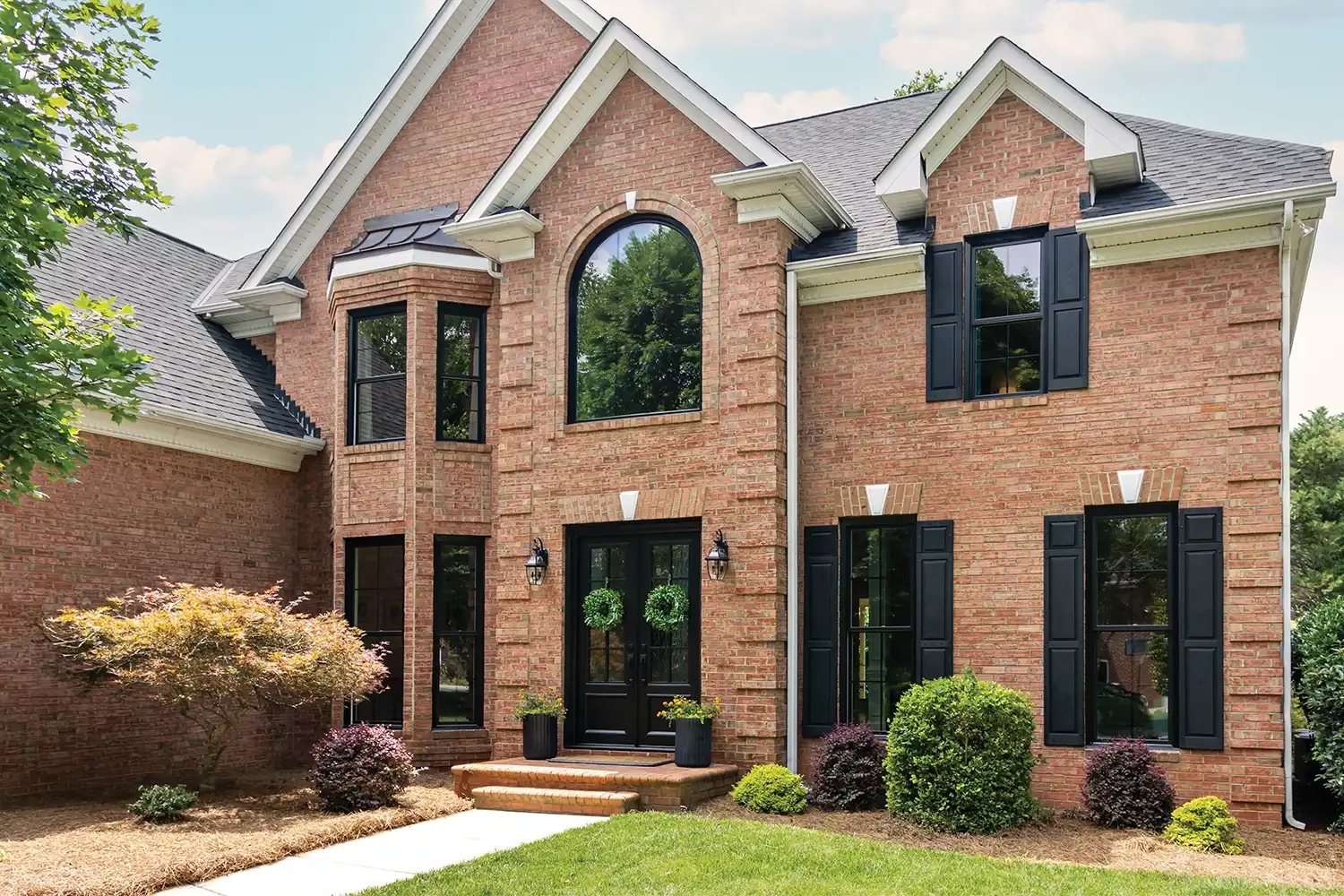
15 April 2024
Types of Replacement Windows
When you’re thinking about replacing old windows in your home there’s a lot to consider. There are many types of windows to choose. You can replace your windows with the same type of window. Or, you could pick a different style of window. Learn more about the types of replacement windows and what to consider as you search for new windows.
Types of Window Replacement
There are two types of window replacement: insert and full-frame. The replacement window installation methods have a slight difference. Insert window replacement uses the existing window frame. Full-frame window installation replaces the existing window frame. Most replacement windows get installed as inserts, sometimes referred to as pocket installation. If a window frame has deteriorated beyond repair, it can mean full-frame replacement.
When to Replace Windows
Knowing when to replace windows can help determine the type of window replacement. A Marvin Replacement design consultant can explain window replacement options. They'll work to find the best windows for you. Leaky windows, drafty windows, and foggy windows signal an immediate need for replacement windows. A home update or refresh can mean researching types of windows to find the right style for your home.
Double Pane Window Replacement
Double pane windows include two panes of glass. They serve as energy efficient replacement windows. An inert, non-toxic gas, like argon, fills the space between glass panes to help insulate. The gas is heavier than air and reduces heat transfer. All Marvin Replacement windows come as double paned. We also have glass coating options tailored to your climate for energy efficiency. Replacing single pane windows with insulated ENERGY STAR®-certified double pane windows can save you between $493 and $568 a year on average, according to the U.S. Department of Energy*.
Most Popular Window Types
Types of replacement windows include: double hung, single hung, casement, awning, arch, slider, bay, and bow. Double hung, single hung, casement, awning, and slider windows rank as the most popular types of replacement windows for homes. Popular window types vary based on home styles and the look homeowners want to create.
Double Hung Replacement Windows
Replacing a double hung window is a common home upgrade for homeowners. Double hung windows have a classic appeal and function that make them a popular window type.
Double Hung Window Pros
Ample Ventilation: With two sash that open and close, a double hung window ventilates a room well. Opening the upper sash allows warm air to escape outside while the lower sash allows cooler air to enter.
Easy Cleaning: Marvin Replacement Double Hung Windows tilt into a room for easy window cleaning. You need to push the tilt release in before lowering the bottom sash into a room. The upper sash tilts in, too, after you pull the tilt latches inward. No need to go outside to wash the exterior side of Marvin Replacement Double Hung Windows.
Traditional Appeal: We designed our double hung windows to look like a wood window but without the maintenance. You can choose our EverWood® interior finish to create the look of wood windows.
Double Hung Window Cons
Interrupted Views: A double hung window’s check rail stands as an obstacle for outside views that some people might not prefer.
Hard to Reach in Spots: Taller double hung windows can be difficult for some to reach the upper sash.
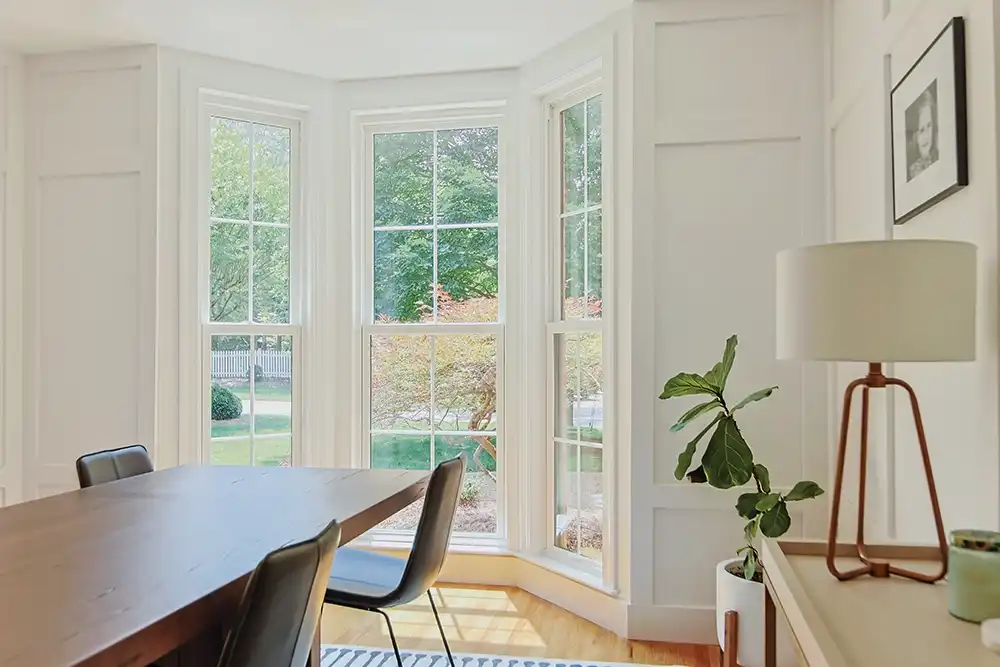
Single Hung Window Replacement
Single hung windows appear the same as double hung windows but function different. The difference between a double hung window vs. a single hung window is you can open both sash of a double hung window. Only the lower sash moves in single hung windows. Marvin Replacement Single Hung Windows have classic style and contemporary appeal.
Pros and Cons of Single Hung Windows
Why choose single hung windows over double hung windows? People choose single hung based on their home style. They can also pick single hung windows for their operation.
Single Hung Window Pros
Simple Operation: Some prefer the easy operation of the lower sash of a single hung window. Single hung windows can work better on first floors of homes.
Traditional Appeal: Traditional style homes often featured single hung windows. Many homeowners like to keep the look and choose to keep single hung windows.
Fewer Opportunities for Air Leakage: In windy areas, like Dallas-Fort Worth, some homeowners select single hung windows. The inoperable top sash reduces the paths for air to leak.
Single Hung Window Cons
Tougher to Clean Upper Sash: Since the upper sash doesn’t tilt in to clean from the inside, it means cleaning it from the exterior. That can be especially tough for second-story windows where you need a ladder to reach the upper sash.
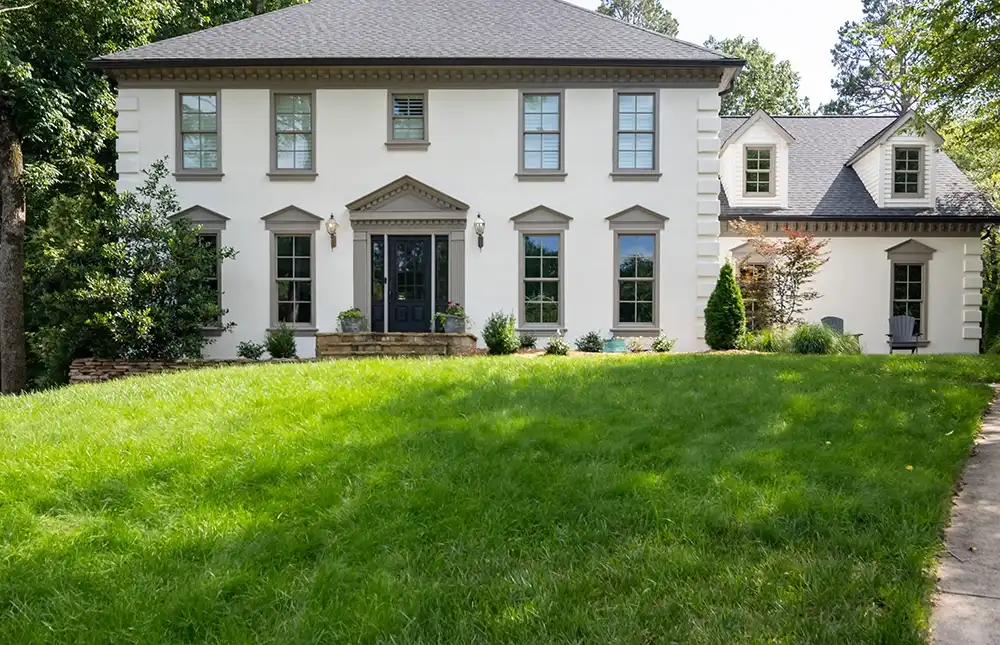
Replacement Casement Windows
Replacing a casement window? Casement windows have advantages over other types of windows. They provide uninterrupted views and open wide for breezes to enter a home. Casement windows feature a crank handle that turns to open the window outward. When closed, casement windows seal tight to prevent air leakage.
Pros and Cons of Casement Windows
Casement windows have several benefits when comparing other types of windows. Their vertical orientation makes them well suited for particular rooms. The crank handle operation of a casement windows makes them easy to open and close, too. Casement windows function like awning windows because they both are crank windows. But there are some differences between awning vs. casement windows.
Casement Window Pros
Uninterrupted Views: Casement windows have large viewing areas and have a clean curbside look. Bay and bow windows use casements because they create terrific viewing space.
Easy to Open: The crank handle operation of casement windows makes them easy to open. An extendable handle works well in hard-to-reach spaces. Homes often use them as kitchen windows. They fit well over kitchen sinks, so you don’t have to reach as far to open them.
Tight Seal: Casement windows close tight with a latching lock to seal out unwanted air.
Casement Window Cons
Swing Outward: The outward swing means they must remain free from bushes and shrubs to open and close smooth.
Can’t Fit Window A/C Units: Not all windows can accommodate window a/c units. The outward swing of a casement window doesn’t allow for a/c units to fit.
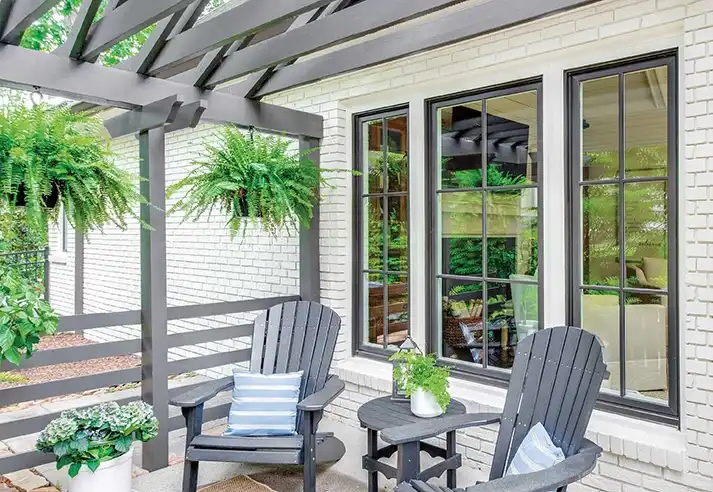
Replacement Awning Windows
Awning windows also open outward but feature a top hinge to create an awning when opened. They also operate by turning a crank handle. Replacement awning windows have design versatility. They can pair with picture windows or appear higher on walls than other types of windows.
Pros and Cons of Awning Windows
Awning windows have advantages over other window types. Their smaller size allows them to fit in tighter spaces. Awning windows also provide excellent ventilation. They often get used as bathroom windows to expel humid air. Our multi-point locking system locks tight to reduce any chances of air leakage as well.
Awning Window Pros
Clear Views: With no check rail, awning windows have clear outside views like casement windows.
Can Remain Open in Light Rains: The top hinge design of awning windows means they can remain open in light rains. They can usher in fresh, cool breezes at the same time.
Ventilation: Awning windows swing open wide enough to help with ventilation. You can use them below picture windows for cool air to pass. Or you can place them high on walls to sweep hot air out. An awning window located high in a bathroom can ventilate the space and provide privacy.
Awning Window Cons
Need Exterior Space: Choosing awning windows means keeping outdoor areas clear so they can open and close.
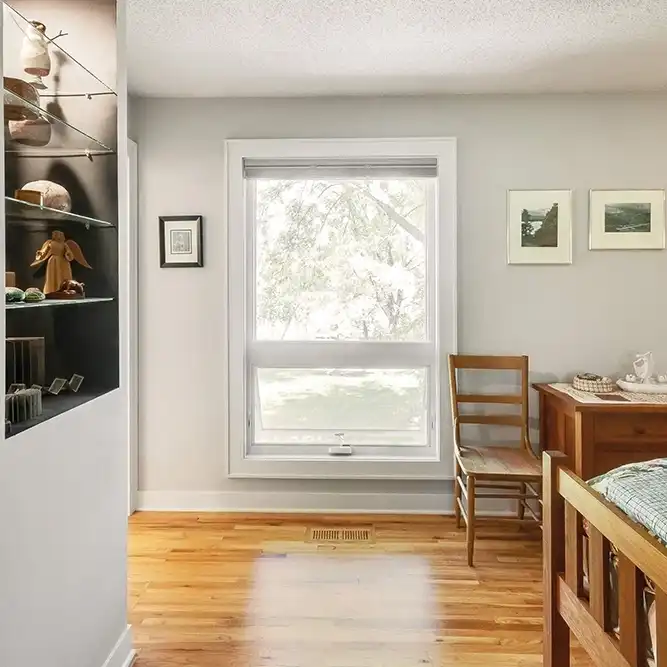
Slider Window Replacement
Slider windows slide open and can come in wide sizes for expanded views. They operate on a roller system for easy operation. You can also select a slider triple sash window for panoramic views.
Pros and Cons of Slider Windows
Slider windows appear in living rooms because they can stretch wide. Like our double hung windows, they can tilt into a room for easy cleaning.
Slider Window Pros
Wide Views: Slider windows come in a variety of sizes to fit almost any space. They add natural light to rooms and stretch views.
Controllable Ventilation: You can open slider windows as far as possible for the most airflow. Or you can open them as little as you like for a little air to pass through.
Space-Saving Function: The sliding action of a slider window makes them great for areas where it’s difficult for a hinged window to open.
Slider Window Cons
Must Remove Debris from Tracks: Our tilt-in function makes cleaning easy. But the tracks must remain clear of debris. Window cleaning tip: a soft bristle vacuum extension works well to clean window tracks.
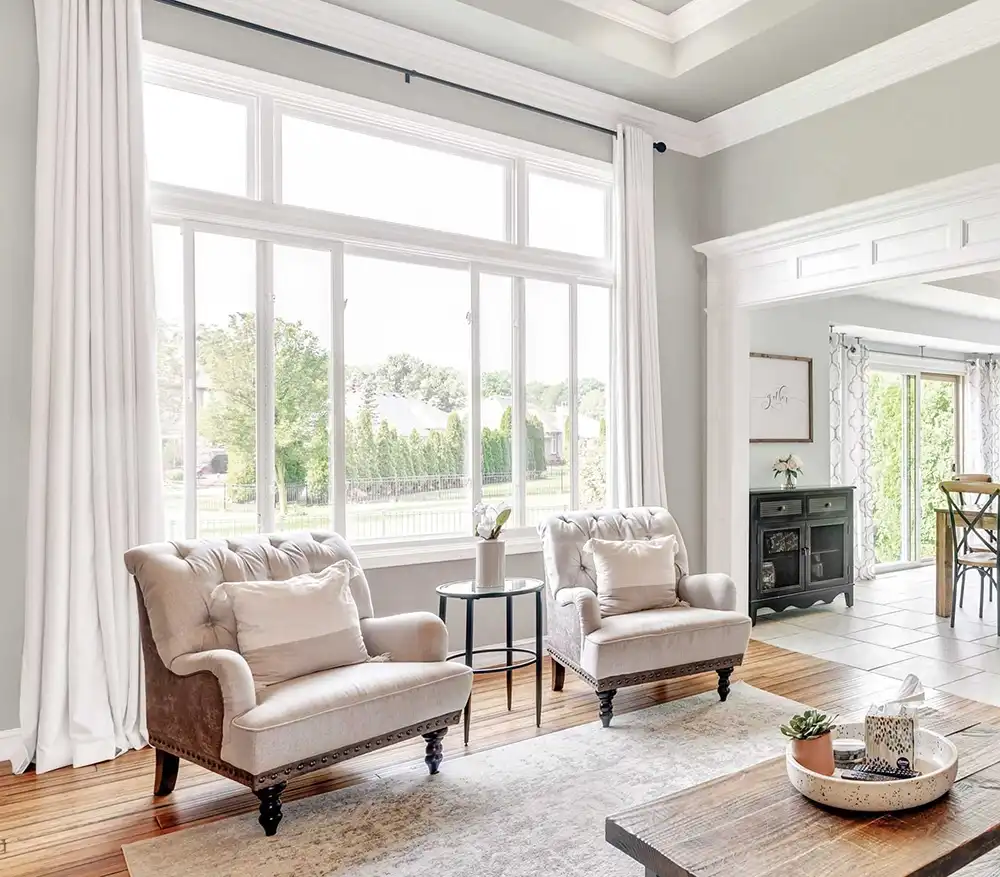
Bay Window Replacement
A bay window is an assembly of three windows mulled together. A bay window can include casement or double hung windows. The flanking windows can come set at 30° or 45° angles. Marvin Replacement Bay Windows can have three operating windows. Or you can include a picture window in the middle. A bay window creates a nice nook area where you can sit to soak up the sunlight. Other bay window replacement ideas include using the space for shelving. The nook can also serve as the perfect place for indoor plants to capture rays of sunshine.
Pros and Cons of Bay Windows
Bay windows make a statement and become a focal point of your home. They enhance curb appeal and angled flanking windows add airflow from different directions.
Bay Window Pros
Design Appeal: Bay windows have incredible appeal to capture backyard or garden views. They often appear in Victorian, Craftsman, and Mid-Century Modern homes. Bay windows add depth to a room because they extend outward. A kitchen bay window that captures the rising morning sun can rouse you for a relaxing start to the day.
Style Variety: Besides window options and angles, there are style options, like window grids. Simulated Divided Lites (SDLs) or Grilles-Between-the-Glass (GBGs) can enhance the traditional details of a home.
Sweeping Views: Bay windows capture serene scenes, like a wooded backyard or colorful garden view.
Bay Window Cons
Space Considerations: Bay windows need a certain amount of space to fit because they include three windows. Not every room has the available space to accommodate a bay window.
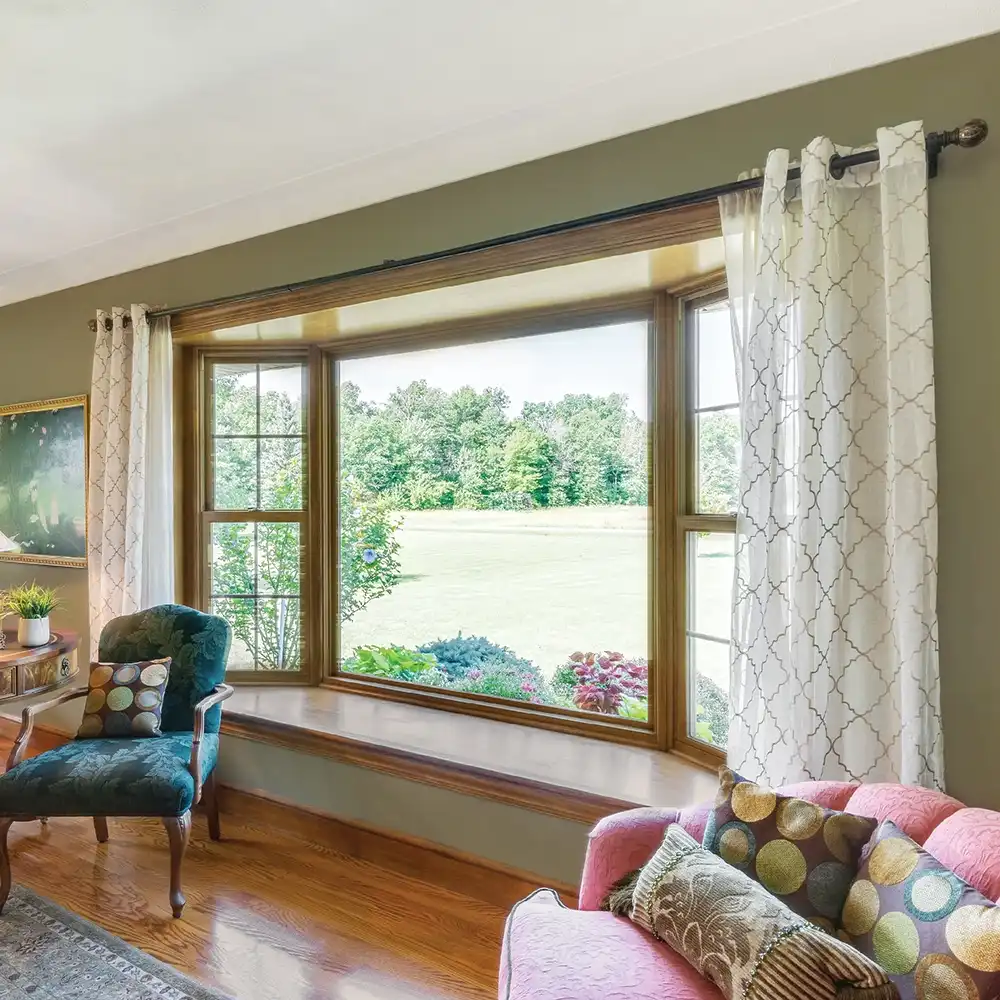
Bow Window Replacement
The difference between bay vs. bow windows is the way they extend outward in a home. Bow windows form an arc. The arc design suits Victorian, contemporary, and Mid-Century Modern homes. Bow windows can also have larger assemblies to include up to six casement windows. Marvin Replacement Bow Windows have four, five, or six-wide configurations. You can also choose to have a wider middle window than the flanking windows.
Pros and Cons of Bow Windows
The unique curve of bow windows presents several pros and cons. Bow windows fit homes with curved architectural features better than rectangular designs. Adding a bow window requires special considerations because of its size.
Bow Window Pros
Design Versatility: Marvin Replacement Bow Windows have several configurations you can tailor to your home. You can style the middle windows to your liking to enhance your outdoor views. You can also pick how many windows, up to six, you want to include.
Panoramic Views: The gentle curve of a bow window lends itself to panoramic views. A six-wide configuration stretches to capture the views you love from your home.
Architectural Appeal: Bow windows extend out from your home to create depth within the home. The outward extension also draws your attention from outside. You can add SDLs and GBGs to accent bow windows for a traditional look.
Bow Window Cons
Size: The size of bow windows presents challenges. They might not fit in some rooms because of their width. Bow windows need a lot of space to install.
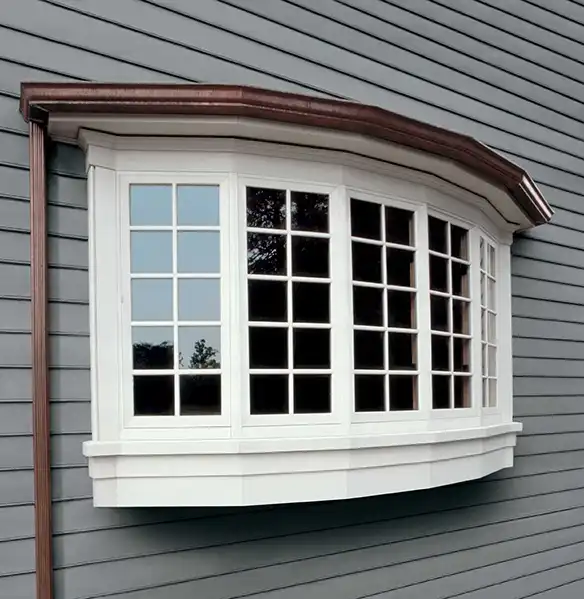
Picture Window Replacement
Picture windows are stationary windows that do not open and close. They’re a great addition to expand views. Picture windows often pair with other windows for bigger assemblies. The larger units increase natural light in your home.
Pros and Cons of Picture Windows
Picture windows have their advantages, but they come with some drawbacks. You can add a picture window almost anywhere to illuminate spaces. But, you can’t enjoy any added ventilation with them.
Picture Window Pros
Better Resistance to Air Leakage: Because picture windows don’t open, there aren’t avenues for air to seep in or out.
Pair with Other Window Types: Picture windows often pair with awning windows to achieve a floor-to-ceiling window look. They also appear as middle units with some bay and bow windows.
Design Flexibility: Picture windows come in a variety of shapes and sizes. Marvin Replacement Picture Windows can grow to as large as 56-square feet. You also choose from seven different shapes to fit almost any space. The ability to fit in different areas mean they can bring more sunlight to your home.
Picture Window Cons
Do Not Open: Since picture windows don’t open and close like other window types, they can’t help with home ventilation. You can add double hung or casement windows to each side of a picture window for airflow. You can also add an awning window below or above a picture window for breezes.
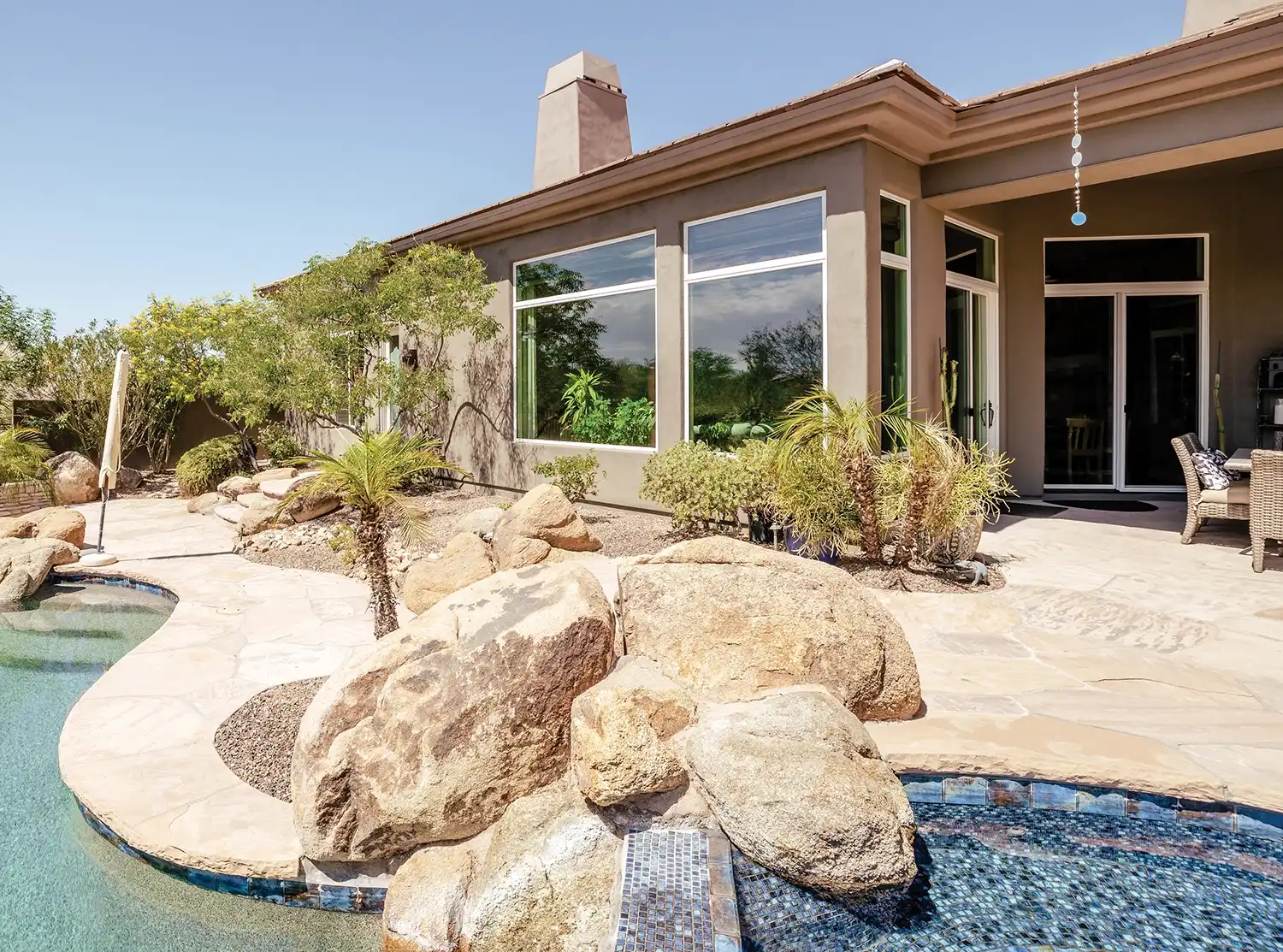
Arch Window Replacement
Arch replacement windows add architectural appeal to homes. Spanish and Mediterranean style homes often have arch windows to match the home’s curves. Picture windows can appear below arch windows to add sunshine to a room.
Pros and Cons of Arch Windows
Arch windows have the unique ability to break up straight lines. The soft curve design can make a room cozy and stylish. Replacement arch windows have several benefits and few disadvantages.
Arch Window Pros
Add Curb Appeal: The arc design of round top windows grabs curbside attention. The disruption of straight lines adds interest to a home.
Low Maintenance: Arch windows don’t have moving parts like other types of windows. That means fewer things to clean.
Style Variety: Marvin Replacement has plenty of arch and round top window options. In all, we have 20 styles you can pick so you can achieve the look you want.
Arch Window Cons
Ventilation: Arch windows have wonderful design appeal, but they don’t function like other windows. You can’t open an arch window for cool air to pass. Marvin Replacement has a solution for those who like round top windows and the ability to open them. Our single hung round top window combines both.
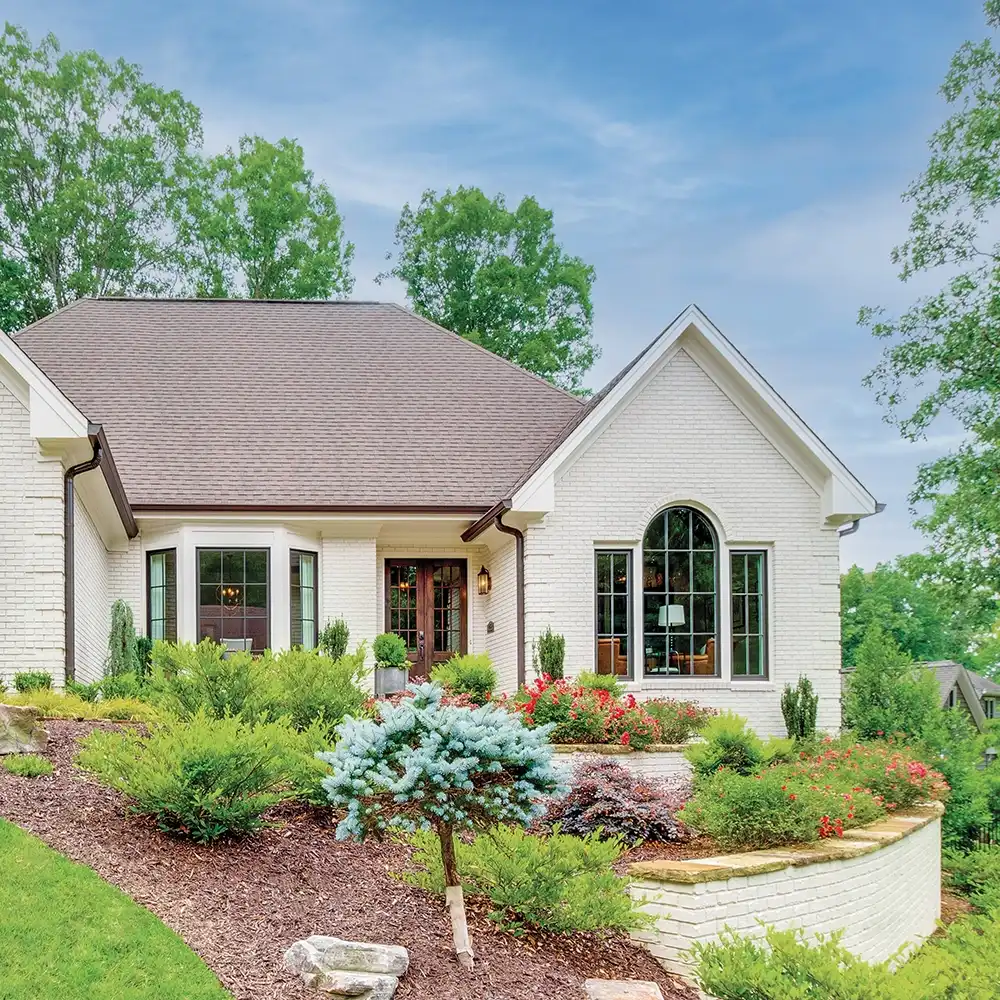
Other Types of Windows
Single Hung Round Top: Marvin Replacement features the one-of-a-kind single hung round top window. It blends form and function together. The lower sash opens and closes to let you enjoy a gentle breeze and grand outdoor views.
Skylights: Skylights appear in ceilings to add natural light in a unique way. They transform spaces with a flourish of style.
Transom: Transom windows often appear above entry doors to illuminate entry ways. They can also appear above interior doors and windows in some cases. They’re an easy way to increase your home’s natural light.
Sidelite: A sidelite, also known as a sidelight, is a narrow, vertical window that stands to either side of an entry door. They help make an entry way feel bigger. Sidelites do not open and close.
Egress Window: An egress window serves as a secondary emergency exit for rooms. They must meet building code requirements to provide a large enough opening. Casement and slider windows are a popular type of window for egress windows. They can have large enough openings to meet code requirements.
How to Choose Window Types
When searching for a window and door replacement company you’ll want to see the types of windows they offer. How they size their windows should factor into your consideration. Marvin Replacement custom builds all its windows to ensure a proper fit. You’ll want to think about how they function in the space you’re considering for it. The way a window looks matter, too. Window colors make a difference. Our acrylic finish is 3x thicker than competitive options. Our finish resists dings, dents, and scratches for a smooth look.
Size: Not sure how to measure a window? No worries, our team measures your windows and verifies them before they get built. Replacement windows need custom sizing because houses settle through the years. As a house settles, window opening dimensions can change. A custom-built window ensures a proper fit better than a standard window size.
Function: The way a window opens and closes makes a difference. Sliding windows suit some rooms better than others. Casement and awning windows need room to open.
Location: The window location matters because it can mean extra considerations. A bathroom window might need decorative glass for privacy. Rooms that need an egress window might need different sizing than other windows in the room.
Appearance: Windows have different orientations, and they can get built with different material. You might prefer the look of a wood window over a vinyl one.
Natural Light: If you value natural light it might lead you to choose a big window like a bay, bow, or picture. You can also consider the amount of solar heat gain you can face with your windows.
Best Types of Windows by Room
Living Room: Bay, picture, casement, double hung. Why? Each adds big views and room for natural light to enter.
Kitchen: Casement, awning, slider. Why? Casement and awnings work well over sinks because they're easy to reach. Each window type can open wide for airflow when you’re cooking.
Bedroom: Double hung, awning, casement. Why? All three provide ample airflow and area for natural light.
Bathroom: Awning, casement, slider. Why? Each window type can open the perfect amount to help ventilate a humid bathroom. Decorative glass options help provide privacy.
Dining Room: Bay, picture, casement. Why? Bay windows offer a cozy nook perfect for morning coffee and bring in natural light, just like picture and casement windows.
Home Office: Casement, double hung. Why? Casement and double hung windows allow you to catch a refreshing draft during the day to keep you going. Both can have big viewing spaces should your mind wander at work.
Window Frame Materials
The most common window materials include: vinyl, wood, aluminum- clad, and fiberglass. Each material has appealing characteristics for homeowners. The type of window material you choose can impact your window’s energy efficiency. Some materials, like wood and our Ultrex® fiberglass insulate better than aluminum. Ultrex is 5,000x less conductive than aluminum. Ultrex fiberglass is also the strongest material in the replacement industry. It has 8x the strength of vinyl to make it a durable replacement window material option.
FAQs
What are the best type of replacement windows?
Marvin Replacement windows rank among the best type of replacement windows available, according to U.S. News & World Report’s 360 Reviews rankings. The best replacement window should provide durability and stability, like our Ultrex fiberglass. Replacement windows also need to look good in your home. Our smooth acrylic finish, along with our seven exterior color options and five interior choices, help make sure your windows look good for years to come. Our windows need next-to-zero maintenance.
*Savings reflects installing ENERGY STAR certified products compared to non-certified when replacing single pane windows based on the average savings among homes in modeled cities. Actual savings will vary by product type, location, method of installation, individual home characteristics, local climate and conditions, utility rates and other factors.
Back to All Articles
You May Also Like

What to Expect with Window Installation
New to window replacement? See what you can expect on installation day so you can prepare.
Window Installation
Choosing the Perfect Color for Replacement Windows
When you replace your windows you'll consider the color you want for the interior and exterior. Explore ideas and things to consider with window colors.
Window Color Ideas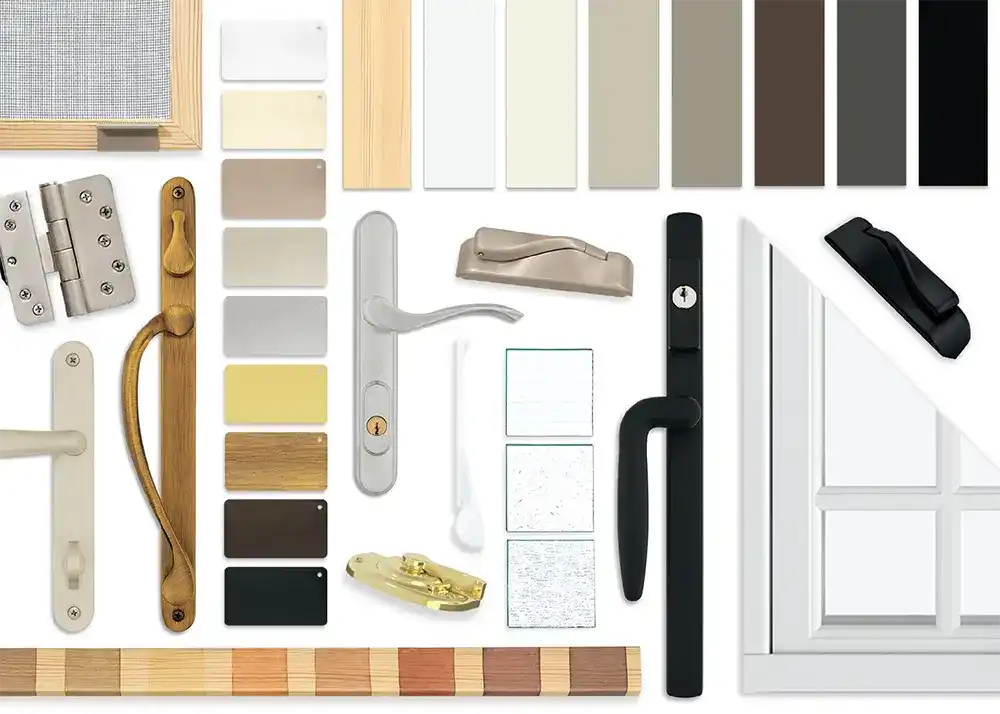
Window Features + Options
Discover the different design and feature options for your windows. View our window color options, hardware styles, and screen choices.
Window Features + Options